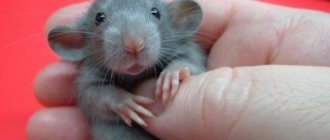Decorative rats were bred from ordinary gray rats through repeated crossing and careful selection. Today, these rodents are viable only in domestic conditions, but domestication is still an important stage in the owner-pet relationship.
Let's find out what rules you need to follow when in contact with a rodent in order to quickly accustom it to your hands.
Is it possible to tame and make friends with a rat?
It is quite possible to tame a rat and make friends with it, both decorative and wild. The latter, of course, will take more time than the home one. But be patient and you will succeed. If you bought a decorative rat from a pet store or from a breeder, then most likely you won’t have to tame it for a very long time. There is a high probability that the animal is already tame and will just need to get used to its new owner.
Did you know? The number of rats on average is twice the population of the Earth; they are believed to have appeared some 48 million years earlier than humans.
But when it comes to taming a wild animal (gray rat), especially one more than eighteen days old, difficulties may arise. Unlike their domestic relatives, wild rodents have a different character. Shy, cautious, withdrawn and unsociable - these animals try to stay away from human eyes. Therefore, in order to tame such a “comrade” you will have to work hard.
But, if your pet, even a domestic one, receives little attention, it can become wild, let alone its wild relative. Therefore, when getting a pet, decide in advance whether you can devote enough time and attention to it. Don't be in too much of a hurry to raise a wild animal. Under strong psychological pressure, the baby rat experiences enormous stress. This can lead to the development of many diseases, and sometimes to his death.
Important! If your pet roams freely around the house, there is a danger of accidentally stepping on it. To prevent this from happening, you need to shuffle indoors and barefoot.
The habituation of a wild animal occurs gradually. Sometimes it takes up to three months to tame an animal. But don’t despair, this period only seems long; once you achieve the result, you will get a more affectionate and devoted friend than domestic varieties.
But even if you brought home a tame animal, do not expect it to immediately begin to play with you and climb on your hands. Any animal needs time to get used to new conditions, different smells, and a home. The normal reaction will be that he will break free from his hands, take refuge in the house, and even the smell of delicious food will not lure him out of there.
Try to make sure that the animal's cage has some kind of shelter where it can hide. Do not force the animal out of him; he may become even more afraid, or even bite. At first, try to avoid loud noises and very bright lighting, which can frighten the baby.
Possible consequences of rat bites
Abrasions, puncture and lacerations, hematomas, bruises are possible consequences of an encounter with a rodent. However, with well-planned treatment and care for the injury, the risk of complications is minimal.
Wound festering is the most common of these. The affected area is opened and drained. This complication can be avoided if you properly care for the wound. In advanced cases, soft tissue may be deeply affected, requiring amputation.
What infections do rats spread?
Rats have long been considered carriers of diseases, including viral ones. Of these, the most dangerous are the following:
- Sodoku is a rat bite disease that is fatal in 10% of known cases. It can be avoided if treatment is started on time;
- tetanus - the risk of death after infection reaches 20–30%. Tetanus ranks third among the most dangerous diseases after rabies and plague. Even after recovery, dangerous consequences are possible in the form of heart paralysis, pneumonia, sepsis;
- Leptospirosis is transmitted not only through saliva. If you notice that the animal has chewed the bread, then it is better not to eat it. The disease is dangerous due to paralysis, myocarditis, renal failure, infectious-toxic shock;
- pseudotuberculosis - dangerous for the development of meningitis, polyarthritis, osteomyelitis, myocarditis.
The risk of contracting rabies is minimal, however, it is a rather dangerous disease that requires prompt treatment.
How long does the addiction process take?
The process of habituation is individual for each animal. Some will be able to tame an animal in a few days, while others will be able to tame it in a month or more. It all depends on the nature of the animal and some other factors. But don’t expect him to climb into your arms or follow you around overnight.
Did you know? Three days
-
a record recorded time during which a rat covered a water distance of 29 km.
Factors influencing the time it takes for a rat to get used to hands:
- The younger the pet is, the faster it gets used to it. But don’t despair, even an adult rat can be trained to another owner.
- The breeder's attitude towards the pups. If he exercises every day and pays attention to them, then they gradually become tamed to his hands. Such animals are very curious and are not afraid to even climb into your arms. Otherwise, the kids will be half-wild, or even wild.
- But we should not forget about the personal qualities of a particular baby. Rats, like people, vary in character and temperament. Some are arrogant, harmful, others are loving, affectionate, and friendly.
In the first stages of taming, do not be afraid to bore your pet. By constantly paying attention to your little rat, you can get a friend who is very attached to his owner. Therefore, take your baby in your arms more often, wear it under outerwear, even if he shows his dissatisfaction. Of course, do this within reason. If he resists strongly, then it is better to leave him alone today.
Did you know? Rat teeth grow throughout the animal's life, so rodents are not afraid to grind them down.
To pick up an unfamiliar rat, hold it from above, hugging its body with your hand; the other hand can support its hind legs and tummy. When you cover the animal with your palm and apply slight pressure, the little rat quickly calms down and does not offer resistance. The more often you play and are with your pet, the faster the addiction process goes.
Conditions of detention
In order for the rat to get used to your hands as quickly as possible, it is necessary to organize comfortable living conditions for it. Only after feeling completely safe can the animal begin to establish relationships with its new owner. The main rule is that there must be enough space in the cage.
Mandatory interior elements include:
- plastic tray with specialized filler;
- cozy house;
- equipment for exercises: wheel, ladder, labyrinths;
- bowl and drinking bowl;
- special sharpener for teeth;
- equipped place to sleep.
The cage needs to be cleaned when it gets dirty. The animal's dishes must be thoroughly washed daily. Once a month, general cleaning is carried out using disinfectants. It is also necessary to ensure that the rat is always fed and there is clean water in the drinking bowl.
Separately, you will need to take care of the microclimate. The room in which the rat is kept must be protected from cold air and drafts. The optimal air temperature for rodents is +18-21°C. Also, rats do not like the sun, so it is better to choose a room on the shady side to keep the animal.
Basic rules for taming
To quickly tame a toothy pet, you need to follow a number of rules, which will be discussed below. To begin with, make sure that your pet lives in a comfortable cage. After you bring the animal home, leave the animal alone for a while. It is advisable not to disturb the rat unnecessarily for several days so that it adapts well to its new home. This will avoid stress for the animal.
Did you know? Karni Mata is an Indian rat temple, in which over several tens of thousands of individuals live.
A pet that is tamed from a young age can make contact with you after a few days. The owner will easily tame him. He will be able to take treats from your hands almost immediately. Wild relatives, in whom the presence of a person causes panic, cannot be immediately picked up. They are very afraid and scream if you try to touch them. Such pets need to be tamed by experienced people, because they will require a lot of patience and attention.
The cage is placed in a part of the house where you often visit, so that the animal gradually gets used to you. However, avoid noisy places and loud sounds. A suitable option is to locate the cage in a quiet corner of the living room. When you talk on the phone (without being overly emotional), your pet gets used to your voice. Try to avoid the hum of electricity, rustling, screaming, rustling. The sensitive hearing of a rat cannot tolerate such sounds.
Be patient. Give your pet time after which he can trust you and want to communicate with you. Any animal requires a special approach; the main thing in this matter is not to despair. Do not pick up the rat until it has settled into its new place. She may get very scared and turn around to bite you, which will negate the entire taming process.
Important! To protect the surface from rat excrement, you need to lay an old blanket in the areas where your pet walks.
Follow these rules for interacting with animals:
- Constantly communicate with your pet through the cage. First for a short time, gradually increasing it. Speak to him in kind words, and only after that, gently try to touch him. You can try to offer your little rat a treat through the cage bars, but he won't always take it from your hands right away. Be patient, the main thing is that your pet sees that you are bringing treats into the cage.
- It is important to teach your pet to treat himself from his owner’s hands. If the rat is not completely tamed, it refuses to eat from your hands. Therefore, give her a piece of some treat every day. It could be vegetables or fruits. Feed her in the crate for several days, getting her used to the treat. When the little rat wants to eat another piece, invite him to take it from your hands. When he does this, you have passed another stage of taming the animal. When opening the cage, offer the rat a piece of treat. Carefully open its door, shake the filled food container, and treat your pet. This will create a close bond with your pet.
- Let your pet sniff your hands. Bring your empty palm to him regularly, so he will gradually get used to your smell. This will protect you from rat bites because your hands will smell like your favorite treat. You will approach the next stage of habituation, when the pet is still scared, but is already interested in you and is ready to eat from your hands.
- Try petting the animal. Alternatively, he won't like it at first. Still try to touch it with your hands regularly. Finish repeated attempts with a treat of your favorite treat. After this, the rat must make contact. Start with one stroke, and after a week or two, try stroking her several times, then increasing. Please note that if the pet resists, this is a normal reaction, but if it is frightened by intense stroking or even screams, switch to shorter strokes. Even though the animal is not interested in this, pet it anyway.
- Show displeasure when your little rat behaves badly. When he bites, shout or squeal back. This will let him know that he needs to change his behavior because you feel pain. Never physically punish an animal, as this will cause you to lose its trust.
- During the day, approach the little rat and talk to him. Open the cage door, invite him to sniff your hand, stroke the animal on the head. Be sure to check if the animal is awake when you touch it. Otherwise he may get scared.
- Sometimes training is carried out using a special device - a clicker, if your pet is nervous. They buy clickers on the Internet and pet stores. The principle of its operation is to create a pattern between a certain sound of the device (click) and pleasant emotions in the rat (receiving a treat). You need to use this thing at the moment when the animal does the action you want.
Do everything measuredly and gradually, do not expect instant results.
Did you know? Rats are fertile. Just one pair is capable of producing 2,000 offspring.
Can a person get sick after being bitten by a pet rat?
Despite the fact that the rodent spends its entire life completely isolated from the environment, it is capable of infecting a person through a bite. This is due to the fact that germs and bacteria from the environment can enter an open wound.
The first signs of infection:
- Severely visible inflammation of the wound. Accompanied by redness, pain and swelling.
- The occurrence of headache or muscle pain.
- Temperature increase.
Some bites can be fatal to humans, especially if not treated promptly. This mainly applies to wild brothers. Animals purchased in unknown places (bird market, hand-held, uncertified pet store, etc.) can also pose a danger to humans.
What you can get infected with:
- Streptobacillosis - another name is Haverhill fever. The disease is dangerous because the lack of treatment in 10% of cases can lead to death. You can catch it not only from a bite, but also from kissing an animal, when cleaning a cage, or from getting a pet’s blood on a small human wound.
- Hemorrhagic fever—infection occurs when animal excrement or urine enters the human body. It can also cause death due to kidney damage. The initial stage is characterized by high fever, headache, hemorrhages on the mucous membrane and skin.
- Leptospirosis is transmitted by saliva, urine and feces, and the rat must also be previously infected. The bacteria of this disease affect the liver, kidneys, and intestines.
- Paratyphoid and helminths - diseases from a series of worms are dangerous not only for humans, but also for rats, they are transmitted through poor hygiene and kissing a pet.
- Tularemia is rare, but can occur in domestic rats; the disease is more common in wild animals and cattle. If ingested, it causes severe fever, loss of appetite, and may cause vomiting and nosebleeds. Hospitalization and treatment with antibiotics are required.
If any symptoms appear, especially inflammation of the bite and fever, you should immediately consult a doctor. You should not take any action on your own.
Antibiotics are prescribed only by the attending doctor after identifying the disease and prescribing a course of treatment. Timely treatment will help avoid negative consequences.
Particular attention should be paid to pregnant women when in contact with animals. It doesn't matter whether it's a rat, a dog, a cat or a cow.
Any animal walking in the yard or living in the apartment, one way or another, can affect the fetus of a pregnant woman.
Steps to Taming a Baby Rat
The rat is tamed in stages:
- At the first stage, teach your pet to approach the cage door to get a treat. This is necessary so that when you need the animal to come to the door, and you don’t have to chase it throughout the cage. Shake the bowl of treats, the rat will perk up and may come to the door. If this does not happen, try to lure it to the door by bringing a tasty morsel under the animal’s nose. You can train her to respond not to the sound of a treat, but to the pronunciation of the pet’s name. To do this, say his name every time before offering a treat. He will get used to his name.
- When offering a treat, lure your pet into your palm. Taking pieces of treats in your hand, stick your palm with them into the open door. When the little rat takes one piece and starts eating, you need to make sure that he has to leave the cage for the next one. The rat will gradually begin to follow the hand with the treat. Gradually move your hand away every day so that at one moment it has to feast on a piece, climbing into your palm.
- Allow the rat to move around outside the cage. If a curious animal wants to get out of the cage and explore the surrounding area, then do not forbid him to do so. Perhaps she will want to eat a treat from your hands and will come up to you for this. Let him eat. In addition, your pet can climb on your clothing; do not make sudden movements. She must trust you. Keep the door to the cage open, the pet will decide when to hide there. This is his shelter and it should be as safe as possible.
- A rat that is accustomed to you can already be picked up. Choose a convenient opportunity for this and carefully lure her into a corner. Don't scare the animal. Say kind words to him and stroke him. After picking up the baby, give him a treat and quickly return him to the floor. The rat should not scream or be afraid; only a slight squeak is allowed.
- Try to hold the rat in your hands until it calms down. Although this is difficult to do with temperamental individuals, release your pet to the ground only when he calms down in your arms. Try to do this immediately after he stops resisting. In the future, gradually increase the time he spends in your arms.
- The rat must be picked up constantly. It's good when you do this every day, at least for twenty minutes, the best time for this is the middle of the day. Do not stop your pet from exploring your body and sniffing you, the main thing is that she spends this period of time in your arms. At first she may try to escape from your hands, squeak and resist, do not allow this to happen. To avoid rat bites, you can first pick up the animal with a towel.
- Play with your pet. When he becomes interested in being with you, and he himself asks to be held in your arms, you can arrange a playground using various devices. Just remember, teach each new toy separately so as not to frighten or tire the rat. And the more time you devote to her, the stronger the connection she will have with you.
The process of getting your pet accustomed to your hands is individual in time, but be patient and he will sit not only in your hands, but also on your head (if you allow it).
Important! Under no circumstances should you pick up a rat by the tail. This is fraught with various injuries to the animal, and sometimes the tail even has to be amputated.
Training rules
- The main condition when working with rodents is to have enough patience.
- Do not force your pet to work against its will. His interest in doing things eliminates many problems.
- Before starting work, the animal should feel slightly hungry. The last feeding should be 10-12 hours before training.
- The first lesson lasts 15-20 minutes. As the duration of study increases, fatigue sets in and the quality of preparation is reduced to zero. In the future, it is possible to increase the time to half an hour, with breaks for rest and the resumption of lessons after games. If there are several pets, then they take turns working with them.
- You can move on to the next lesson only after mastering the previous one.
- When performing the movement, do not touch the animal with your hands, only scratching when expressing gratitude.
- Give lessons daily, starting first with repeating what you have learned.
- You cannot talk to your pets when learning a number, only commands or sound signals.
- When training rats, actions that cause pain are not allowed.
Affectionate treatment and food encouragement have the best effect on results. To do this, feed sunflower kernels, boiled meat, slices of bananas, baked apples, vegetables, and nuts. Preference is given to those food products that the pet loves. The main condition for this will be the size of the portion of gratitude. It should be small and not saturate the animal. To prevent the animal from getting bored, food is changed more often. Alternating training with games will enhance the quality of the process.
The gingerbread method is very useful in training
Rodents are more energetic in the afternoon, so it’s best to schedule studying at this time of day. The success of the activity depends on the location. If the place is familiar, then the animal feels safe. The exercise area should be wide and not hazardous to the health of the pet. Before starting the exercise, he is given time to master the space and become familiar with the props. The rat must be trained daily. During the lesson, she is taken out of the cage, taught and put back. As soon as the required element is completed correctly, training for a specific action is stopped. If permissible occupational norms are violated, the number of portions of reward increases. The animal gets fat, becomes inactive, and loses interest in the process.
You cannot postpone the lesson without consolidating the result. The rodent develops a reflex: complete the task, receive a reward. If the number is performed accurately, a command is pronounced and an award is immediately given. After practicing the skill, the feed is stopped and limited to only stroking.
The animal receives gratitude only during work. Undeserved receipt of tasty food violates the rules of training and reduces the results to zero. In addition to commands, signals in the form of a whistle or click are used. The signal is given at the moment of correct movement.
There are 3 points noted in the training technique:
- Make the student make a movement.
- At the same time give a signal, an order.
- Reward with a treat.
Until the rat understands the task and does not enjoy it, the work causes it stress. Only patience, praise, encouragement and affectionate treatment will help to correctly form new skills and abilities. When playing games, safety measures are observed. You should not leave a baby rat alone with a child. The baby’s activities are unpredictable and, due to oversight, can cause harm to a living creature. Wires, as well as sharp, piercing, and cutting objects are not used as accessories. Sheets of paper from magazines or newspapers are not allowed. Printing ink is poisonous and will harm the student. Lessons are not taught on a surface high above the floor. There is a risk of falling from height and injury. Before the lesson begins, the little rat is tamed and taught to respond to its name. When an animal becomes attached to a person, it ceases to be afraid of him
What to do if the animal is afraid, bites and breaks out
By its nature, the decorative rat is completely non-aggressive. Although there are some exceptions. But, nevertheless, in many cases, bites are not a manifestation of anger, but a defensive reaction. Therefore, you need to understand the question of why the animal began to bite.
If the little rat had not bitten before, and then began to do so, then most likely your behavior or that of your family members has shaken his trust. Remember if you have pushed, pinched or stepped on an animal recently. Such actions, like physical punishment, can cause not only a desire to bite, but also fear. In addition, a tamed animal can escape from one’s hands, although there were no problems before. Physical pain for a pet is a threat to it, so this behavior is a defensive reaction of the rat.
But the desire to bite does not always mean aggression. In the natural environment, rats use it to communicate with each other. And you are now part of her family.
Bites can mean many things:
- interest - the animal gently nibbles with its teeth;
- thirst for affection - bites as if biting off the fur of a relative;
- showing superiority - trying to show with a bite who is in charge in the family;
- attracting attention - a sudden bite from an unexpectedly visiting pet;
- playful mood - bites, runs away and comes back;
- warning - a response to your actions, as an option it hurts him;
- fright - after a bite the pet runs, breathes heavily, wants to hide.
During puberty (at 5–7 months of life), males may begin to bite, hiss and snort. This is hormonal maturation, growing up and defending territory. Females mainly bite when they are pregnant or caring for pups.
Also find out how to teach a rat to go to the toilet in a litter tray.
To prevent your pet from becoming aggressive, you need to:
- provide the rat with peace during the adaptation period;
- do not insert food or fingers between the cage bars, only through the door;
- play with the animal every day;
- reduce the noise level around your pet;
- Do not hit the rat under any circumstances.
Any attempts to bite must be stopped. If a rat bites, drive it away from you. She will quickly understand that this cannot be done. If a rat bites you, you must squeeze out the blood from the wound to prevent inflammation, treat it with peroxide and an antiseptic. You can visit the hospital if you wish. The main thing is that the animal is vaccinated.
If the wound is severely inflamed, there is a headache or muscle pain and fever - this is a reason to seek help at the hospital. Manifestation of aggressiveness is a kind of rebuff to your behavior; correct it, and the animal will begin to trust you again.
Answers
Evil Fairy 6 (17408) 3 24 1148 6 years
Better than green paint, it is less aggressive to the skin of children.
Aksi 6 (12738) 2 7 177 6 years
Peroxide and only peroxide should be used to disinfect ANY wounds (applies not only to children). The pharmacy costs about 0.48 ls. You literally need to water the wound 2-3 times a day, do this for a couple of days and everything will heal.
Alessio 5 (3835) 1 25 78 6 years
When I was a child, I had a hamster that was so fluffy and had huge yellow teeth. My parents told me that if you put your finger in the cage it will bite, but I’m not a fool, I decided to check... my hamster pierced my finger, right through. it hurt, at first I cried, then I laughed for a long time :]]] they anointed my finger with iodine and everything healed. this is my story
Mruta_ 7 (21254) 7 79 213 6 years
If the rat didn’t live in garbage dumps, then it’s okay, just disinfect the wound. Home for me too. The rat even bit my finger once until it bled, it hurt, but nothing tragic happened)
hawketeer 6 (16339) 4 13 63 6 years
If the rat is vaccinated, then wash the wound and transport it.
asdf777 6 (8227) 2 2 18 6 years
Sorry, not a doctor, that's why. in general, I would definitely show the doctor and still use the antibiotic intramuscularly. Why? Yes, the rat is a domestic one, but what did it eat? How clean are her teeth? And this infection can enter the baby’s blood and cause sepsis. This is not harmless at all! Zelenka and iodine are only disinfected on the outside, a bandage is not needed at all, the band-aid is also nonsense. Damn, why the hell give advice if you don’t understand them. This is a small child.
You can choose completely different pets - large, small, bald, hairy, with a variety of colors and characters. When purchasing a decorative rat as a pet, you should follow several rules to ensure safety. The rodent has sharp teeth and claws. If necessary, he can use them. A rat bite, painful and unexpected. Why did your beloved pet suddenly start showing aggression? Let's figure out what to do if bitten by a rat?
Veterinary assistance
At the veterinary clinic, the first thing they ask is about the completeness of the vaccination. If everything is in order with vaccinations, then the veterinarian will simply record a case of a bite. If there are no vaccinations or the vaccine was administered insufficiently, then the dog will undergo a course of vaccination. The most commonly used serum is for tetanus, rabies and leptospirosis.
A rat bit a dog, what should you do if your pet was not taken to the vet? – There are times when a dog owner decides to limit himself to treating a bitten dog with improvised means. In such situations, you need to strictly monitor the condition of your pet. The following symptoms may be cause for concern and a trip to the veterinarian:
- change in gait;
- convulsions;
- excessive salivation;
- disruption of normal behavior;
- temperature increase.
If you notice suspicious symptoms after your pet has been attacked by a basement rat, you should immediately take the dog to the veterinarian.
How do rats bite?
Rats almost always bare their fangs in an open fight. The instincts of our smaller brothers lead to a clash. Dogs almost always try to chase down a rat. You will be lucky if several or even more dogs chase the rat at once. Hunting group tactics consist of one dog blocking the rat's path, and the second pressing it with its teeth. Dachshunds and Yorkshire terriers are considered natural rat catchers. By the way, small Yorkie dogs were bred specifically for these purposes, that is, to chase rodents around.
Causes
To maintain good, friendly relationships, you should avoid situations in which the rat might bite.
The pet was hurt; Scared; Hungry animal; The desire to attract attention.
Bites without a reason in domestic rats are practically excluded. If you squeeze an animal for a long time, then when it gets tired, it can gnaw lightly, thereby saying “enough.”
After preparing or eating food, you should also wash your hands thoroughly so that the smell of your fingers is not confused with food.
A rat may also bite another pet, such as a cat or dog. The reasons are the same - protecting one’s territory, fear, approaching danger. It happens that pets get along nicely next to each other and even play.
With a strong bite, the wound may not heal for a long time, especially in an animal when there is fur nearby, which constantly irritates the “battle wound.” Bites are painful, but by providing comfortable conditions for all family members to stay in the house, they can be avoided.
How to tame a small pet
How to train a rat at home
As a rule, it is easier to train a small rat than an adult.
Little pasyuk of the Dumbo breed
Experienced specialists suggest using the following algorithm to complete the task:
- Place your pet in a cage.
- By analogy with the previous point, place the cage next to you. For example, if a person is cooking in the kitchen, then the cage with the rat should be next to it on the table.
- Monitor the animal's reaction. Most likely, he will carefully observe the person's actions. However, in some cases the rodent will try to hide. Here, too, much depends on the specific breed.
- You can skip the stage of walking around the house and immediately start feeding the animal.
- Place some treat next to the cage and wait for the little rat to approach it. If he started eating, it means he liked it.
- When feeding for the first time, you should not get close to the rat. She may regard this action as an attack and hide.
- Wait until the little rat eats the food and goes back into the cage, after which it will need to be closed.
- Give your pet the same treat after a while, but from your own hands. If the rat starts eating, then the training was successful.
Note! After several such feedings, you can safely pick up your pet. The animal will already expect to be fed again
Hand feeding a pet rodent
The little rat's brain is not yet very developed, so it quickly gets used to home conditions and its owner, especially if the pet has not lived in the wild before.
Bitten by a rat, what to do - why is a rat bite dangerous?
The rodent is a carrier of infectious diseases that are fatal to humans. The oral cavity of an infected rodent contains saliva, which contains dangerous poison. The poison can cause “rat fever,” which is the common name for streptobacillary fever and sodoku disease. A painful condition in a person, in which high fever, nausea, swelling, discoloration and the presence of a rash on the skin may occur, usually occurs 2-4 days after the bite.
What to do if bitten by a domestic rat until it bleeds - treatment
Prevention and treatment measures for wounds should be known to everyone, since timely assistance can even save a life. You never know how healthy a rodent lives in your cage at home, so it is imperative to take preventive measures if a rodent has bitten. And when we are talking about a wound received from a wild individual, a visit to the doctor and tests are required, since such a specimen can carry up to 20 infectious agents in its saliva.
First aid should look like this:
• The damaged area must be washed with water and an antibacterial agent for 10 minutes. • Then blot the wound with cotton wool soaked in medical alcohol, • brilliant green or iodine and treat continuously for 5 minutes.
Chills, muscle spasms, increased roughness and swelling around the affected area, discoloration or increased redness of the skin, as well as the pouring of a pus-like mass from the wound - these are clear symptoms that the bite must be urgently shown to a rabbiologist - an infection may develop. Every day you need to measure your basal body temperature. If it is elevated, it means the wound is inflamed and requires serious treatment with antibiotics.”
Consequences of a domestic rat bite
The consequences of a pet rat bite can be very sad. If you do not take any measures to disinfect the wound immediately after receiving an injury, you can become infected with “rat disease.” Of course, if you properly care for your rodent, there is nothing to fear, but it is still worth knowing the preventive measures and possible dangerous manifestations.
A rodent's saliva may contain about 20 infectious agents. The most dangerous and severe are the rabies virus, tetanus and toxoplasmosis. These infections have a devastating effect on the human body, in some cases even fatal. To avoid possible infection, you need to go to the clinic as soon as possible. The doctor will examine the wound, pre-treat it with special disinfectants and send you for all tests to possibly detect the virus.
What to do if bitten by a wild rat?
We live in cities where the number of wild rats has recently increased. These synanthropic animals settle in hallways, warehouse buildings, garbage dumps, and sewers. According to statistics, attacks by wild rodents are rare, but this does not make them any less dangerous, so preventive measures to avoid infection are mandatory.
Rodents bite all people, regardless of age; most often children become victims while out for a walk. The most common way to be bitten by a wild rat is in a dream, or on the street, on exposed parts of the body, usually the hands and fingers. A rat attacks if it sees a person as potentially dangerous to itself or its offspring. The risk of contracting viruses when bitten by a wild rat increases compared to a decorative one.
First aid for a wild rat bite is to treat the wound with a mixture of laundry soap and water in equal proportions, then apply iodine and apply a bandage. After which, immediately go to a specialist-rabiologist.
A rat bit a cat, what should I do?
For a cat, as for a person, a rat bite has serious consequences, such as suppuration of the wound and infection through the blood. Infection is inevitable if measures are not taken in time to initially treat the wound and visit a veterinarian. Wash the bite site with hydrogen peroxide or chlorhexidine, lubricate it with levomikol for 5 days. Veterinarians recommend immediately seeking advice and further treatment. To avoid infection, it is necessary to vaccinate the animal on time.
How to treat a rat bit a dog?
Treating a dog is similar to caring for a cat. Only an unvaccinated dog can become infected with rabies, since vaccinations protect against possible viruses and diseases. Be sure to treat the wound with an antiseptic, trim all the hair around it so that it does not get in, apply a sterile bandage and carefully monitor the condition of your pet. Inflammation around the wound, poor appetite, poor coordination of movements are reasons to urgently visit an animal clinic.
Harm at home
Many people become aware of the presence of rats in their home through spoiled items and chewed food. If traces of the presence of rats are detected, it is necessary to immediately take measures to destroy them. This type of rodent has teeth that grow throughout its life, which is why they are forced to grind them down. They are capable of chewing not only paper, wood, plastic, they can even chew concrete and cement. Rats often chew on wires, which leads to equipment malfunctions and even fires. Rats are not picky eaters, but most of all they love grains and vegetables, and can destroy large stocks, which is especially dangerous in industrial warehouses.
Why are they hard to get rid of?
Having learned how dangerous rats are, you want to get rid of them as soon as possible, but this is not at all easy. Rats have adapted to life in urban environments, and thanks to their intelligence and teeth, they are able to conquer territory from other rodents, as well as kill a cat or dog. These animals adapt to any conditions, they are not afraid of either cold or heat, which is why they find a place to live everywhere. In addition, these rodents reproduce very quickly, which helps them fill the planet. During its life of 2-3 years, a rat can give birth to up to 6,000 cubs.
Rats cannot be poisoned by food because even when they are hungry, they do not eat poisoned food. And also, when they sense danger, they secrete a liquid with an odor, which warns other members of the species. And recently, scientists have discovered a new species of rats that are especially dangerous because they are not affected by practically any poison.










